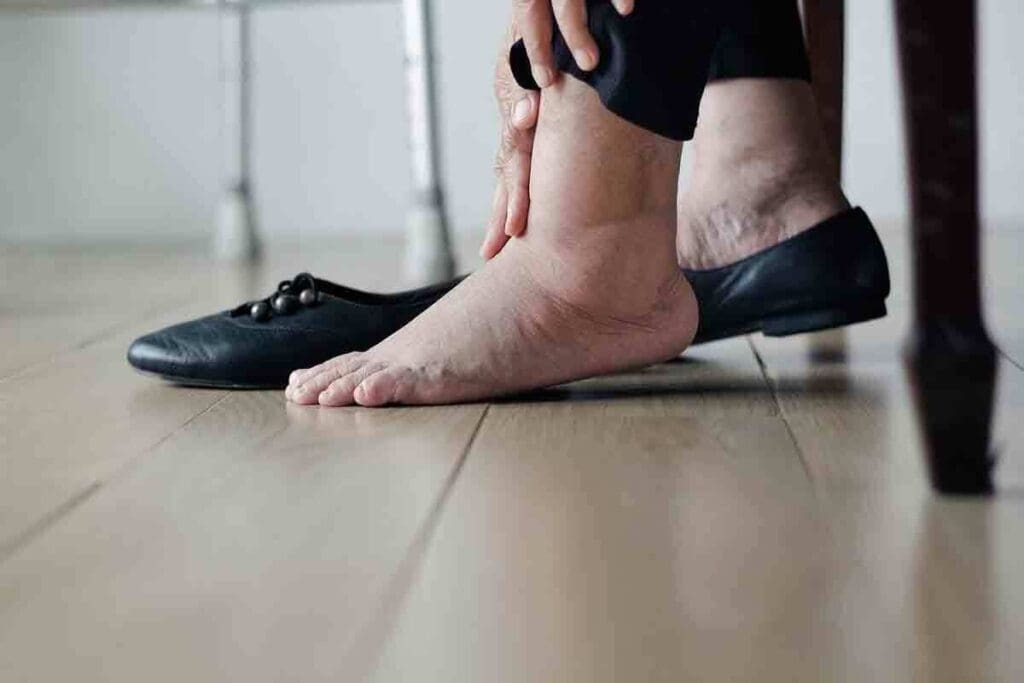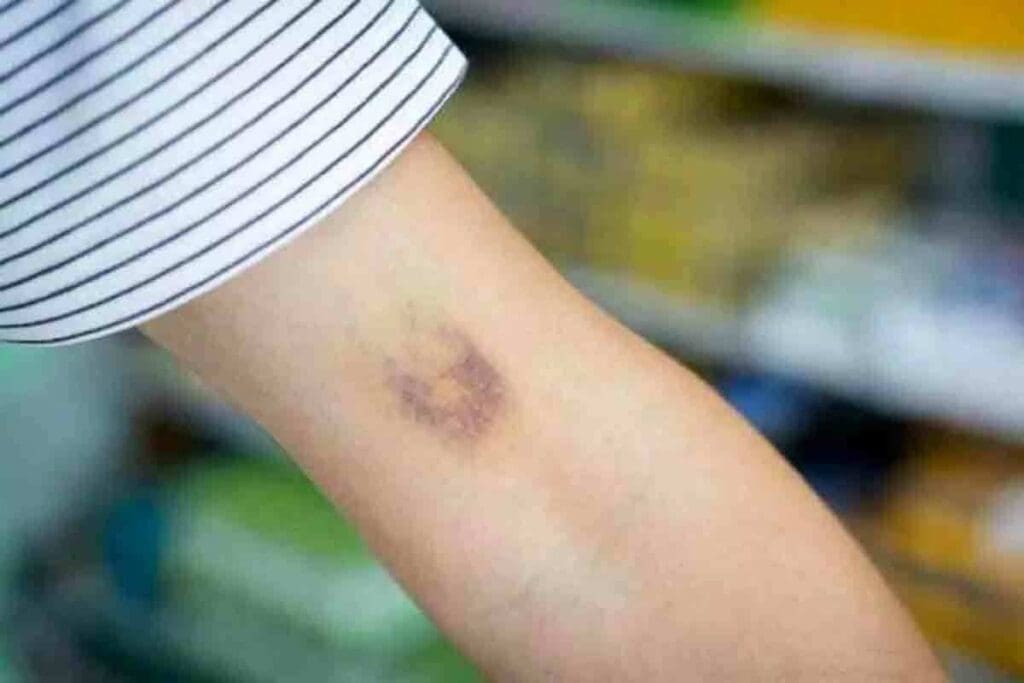Last Updated on November 17, 2025 by Ugurkan Demir

A painful or swollen wrist might not just be a minor injury. It could signal a serious condition like a blood clot. Liv Hospital is a trusted partner for patients, providing expert care for every symptom.
Symptoms of a blood clot in wrist include swelling, pain, warmth, and color changes. Visible veins can also be a sign. It’s important to catch these symptoms early because they can resemble other issues like sprains.
A blood clot in veins or arteries can cause serious health problems. If you notice any symptoms, get medical help right away.

Blood clots are more common in the legs, but they can also happen in the wrist. These clots in the wrist are less common but serious. They can cause pain and lead to serious problems. They usually form in the wrist veins due to injury, overuse, surgery, or clotting conditions.
A blood clot in the wrist is a mass of blood cells and proteins in the wrist veins or arteries. It happens when blood clots abnormally, often due to injury or other factors. Blood clots in the wrist can be dangerous if they block blood flow or travel to other parts of the body.
Blood clots in the arm or wrist are rare compared to leg clots. They can happen, though, in people with certain health issues or after medical procedures. Risks include trauma, staying immobile, and medical conditions that affect blood clotting.
Deep Vein Thrombosis (DVT) usually happens in the legs, but it can also occur in the wrist. When it happens in the wrist, it’s less common but just as risky. Prompt medical attention is key if you notice DVT symptoms in your wrist.

It’s important to know the signs of a blood clot in the wrist. These symptoms can seem minor at first but can become serious if not treated quickly.
Pain is a key sign of a blood clot in the wrist. The pain can feel like a dull ache or sharp stabbing. It usually happens in the area of the clot and can get worse when you move your wrist or apply pressure.
Swelling is another common symptom. It’s caused by inflammation from the clot. Your wrist might look swollen, feel tender, and warm. Sometimes, the swelling can make it hard to move your wrist.
The skin around the clot might change color or feel warmer. This is because of increased blood flow. The skin might also look pale or blue, showing poor circulation.
The symptoms of a blood clot in the wrist can vary. It’s important to notice these signs early to avoid bigger problems.
| Symptom | Description | Severity |
| Pain | Dull ache or sharp pain, often localized | Variable |
| Swelling | Visible swelling, tenderness, warmth | Mild to Severe |
| Skin Changes | Redness, discoloration, warmth, or paleness | Mild to Severe |
A blood clot in the wrist can show up in different ways. These signs can be subtle, so it’s important to know what to look for.
A blood clot in the wrist can change how it looks. You might see swelling, redness, or discoloration of the skin. The skin might also feel warm or look slightly bluish because of the clot.
To learn more about blood clots, check out this resource. It explains the difference between blood clots and bruises.
Looking at a normal wrist and one with a blood clot shows the differences. A wrist with a clot might have:
A normal wrist doesn’t usually show these signs.
| Characteristics | Normal Wrist | Wrist with Blood Clot |
| Swelling | No swelling | Visible swelling |
| Skin Color | Normal skin color | Redness or discoloration |
| Vein Appearance | Normal vein appearance | More pronounced or tender veins |
One sign of a blood clot in the wrist is changes in the veins. The veins might look more noticeable or feel tender. Sometimes, the vein can be hard or cord-like because of the clot.
Knowing these signs can help spot a blood clot in the wrist. If you think you have one, getting medical help is key for the right diagnosis and treatment.
Blood clots in the wrist can come from many sources. These include injuries, health conditions, and lifestyle choices. Knowing what causes them is key to preventing and treating them.
Getting hurt in the wrist can lead to blood clots. This can happen from:
When the wrist gets hurt, the body tries to stop bleeding by clotting. But sometimes, this can cause unnecessary or too-large clots, leading to problems.
Some health issues can make you more likely to get blood clots in the wrist. These include:
Wrist or arm surgeries can also raise the risk of blood clots. This is because of:
After surgery, doctors often use anticoagulant meds and encourage early movement to prevent clots.
Our lifestyle and environment also affect our risk of getting wrist blood clots. These include:
By knowing these causes and risks, we can take steps to prevent them. If symptoms show up, getting medical help can help avoid serious problems from wrist blood clots.
It’s important to know how blood clots form in wrist veins. This knowledge helps doctors diagnose and treat them quickly. Blood clots in the wrist can cause serious problems if not treated fast.
The wrist has a complex network of veins and arteries. These supply blood to the hand. The veins in the wrist are more likely to clot because of their structure.
The venous anatomy includes both superficial and deep veins. Superficial veins are near the skin, while deep veins are deeper and more likely to clot.
Blood clotting happens naturally when there’s an injury. It involves several steps to form a fibrin clot. In the wrist, this can start from trauma or other causes.
The clotting process needs platelets, clotting factors, and fibrinogen. When a vein gets injured, platelets stick to it. Then, a series of chemical reactions creates a clot.
Several things can make blood clots form in the wrist. These include trauma, medical conditions, and lifestyle choices.
| Risk Factor | Description |
| Trauma or Injury | Direct injury to the wrist can cause blood clot formation. |
| Medical Conditions | Conditions like deep vein thrombosis (DVT) or clotting disorders increase the risk. |
| Lifestyle Factors | Prolonged immobilization or certain medications can contribute to clot formation. |
Knowing these factors is key to preventing and treating blood clots in the wrist.
Diagnosing a blood clot in the wrist requires a few steps. These include a physical check, imaging tests, and lab tests. It’s important to catch it early because symptoms can be similar to sprains.
A doctor will start with a physical check. They look for swelling, redness, and warmth in the wrist. They also check for tenderness and pain when moving or touching the area.
Key physical examination techniques include:
To confirm a blood clot, imaging tests are needed. These include:
Laboratory blood tests help diagnose blood clots. They measure substances in the blood. These tests include:
Differential diagnosis is key to accurately diagnosing a blood clot in the wrist. Healthcare professionals must consider other conditions that may present with similar symptoms, such as:
By combining physical examination findings, imaging test results, and laboratory test data, healthcare professionals can make an accurate diagnosis and develop an effective treatment plan.
The main goal of treating a blood clot in the wrist is to stop it from getting bigger or breaking loose. This can cause serious problems. The treatment depends on the clot’s size, location, and the patient’s health.
Anticoagulant medications are often the first choice for blood clots in the wrist. They help prevent the clot from growing and stop new clots from forming. Common ones include:
These drugs need careful monitoring to avoid bleeding problems.
In severe cases or when there’s a high risk, thrombolytic therapy might be used. This treatment breaks down the clot with drugs. It’s for emergency situations where the clot is a big threat.
Surgery might be needed for some wrist clots. Procedures like thrombectomy remove the clot. Surgery is for cases where other treatments don’t work or are not possible.
Home care is also important for recovering from a blood clot in the wrist. This includes:
Following your healthcare provider’s advice and going to follow-up appointments is key. This ensures proper healing and any needed treatment changes.
If a blood clot in the wrist is not treated, it can cause serious problems. These can range from minor damage to life-threatening conditions. The risk to your health is very high.
At first, a blood clot in the wrist might cause pain, swelling, and stiffness. These symptoms can make everyday tasks hard. Sometimes, the clot can lead to post-thrombotic syndrome, causing long-lasting pain and swelling.
A big worry with a blood clot in the wrist is that it might move to other places in your body. This could lead to serious issues like pulmonary embolism. This is when the clot goes to your lungs and can block blood flow, which is very dangerous.
Not treating a blood clot can harm your blood vessels over time. This can lead to chronic venous insufficiency. This makes it hard for veins to return blood to the heart, causing swelling, pain, and skin changes.
In severe cases, a blood clot in the wrist can be very dangerous. For example, if it breaks loose and goes to your lungs, it can cause a pulmonary embolism. Getting medical help quickly is key to avoiding these serious problems.
Knowing when to get medical help for a wrist blood clot is key to recovery. A wrist blood clot can cause serious problems if not treated quickly.
Certain symptoms mean you need to see a doctor right away. These include:
If you notice any of these signs, get medical help right away. Waiting can cause permanent harm or even be life-threatening.
Other symptoms also need attention. These include:
Keep an eye on these symptoms and see a doctor if they get worse or don’t go away.
After treatment, follow-up care is vital. It helps make sure the clot is gone and prevents new ones. This may include:
| Follow-up Care | Description | Frequency |
| Medical Check-ups | Regular visits to monitor clot resolution and overall health | As advised by your doctor |
| Medication Adherence | Taking prescribed anticoagulant medications | As prescribed |
| Lifestyle Adjustments | Making necessary changes to reduce risk factors | Ongoing |
Following these guidelines is important for successful treatment and avoiding complications.
Getting medical help quickly is key to treating and preventing problems. If you think you have a blood clot in your wrist, don’t wait to get help.
A blood clot in the wrist is serious if not treated. Knowing the symptoms is key for early action and care.
Blood clots in the wrist can be very painful. They might also lead to serious problems. It’s important to notice the signs and get help fast.
Can you get a blood clot in your wrist? Yes, it’s possible. Knowing the risks and symptoms is vital. Early treatment can help a lot and prevent harm.
With quick medical help and the right treatment, wrist blood clots can be managed. It’s important for people to know their risks. They should also seek help if they notice unusual symptoms.
Symptoms include pain, swelling, and skin changes. You might also notice temperature changes in the wrist.
Yes, sometimes you can see a blood clot. It might look like swelling, redness, or a lump.
Risk factors include wrist injuries and certain medical conditions. Surgery and long periods of not moving can also increase risk.
Doctors use physical exams and imaging tests like ultrasound. They also do blood tests and rule out other conditions.
Treatment includes medicines to prevent clotting and surgery. Home care helps manage symptoms and prevent problems.
Yes, complications can include local issues and clot movement. Long-term damage and serious problems like pulmonary embolism are also risks.
Get help right away if you have severe pain, can’t move your wrist, or see signs of clot movement.
While rare, wrist blood clots are like DVT. They need quick medical care.
Yes, a healthy lifestyle and avoiding long periods of rest can lower risk. Managing health conditions also helps.
Signs include sudden chest pain, trouble breathing, or pain elsewhere. These need immediate medical help.
Look for pain, swelling, redness, or warmth. If you notice these, see a doctor for a proper check.
Subscribe to our e-newsletter to stay informed about the latest innovations in the world of health and exclusive offers!